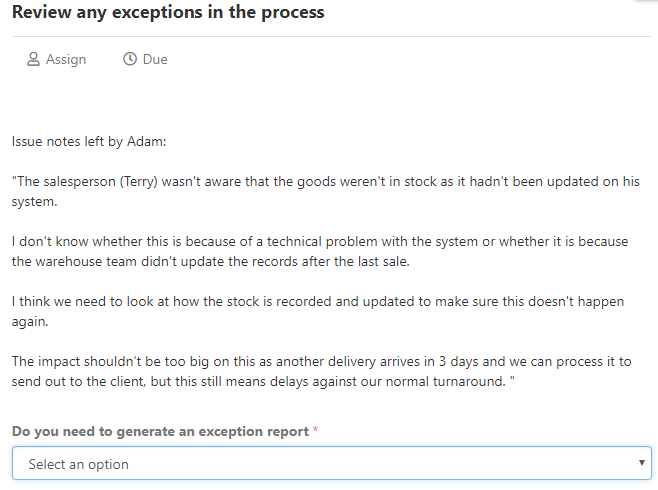 Part of the reality of trying to manage operations in organizations of any size, is understanding that sometimes things go wrong.
Part of the reality of trying to manage operations in organizations of any size, is understanding that sometimes things go wrong.
In an ideal world, we don’t want anything to go wrong. We want our processes to run smoothly and all tasks to be easily completed.
But that isn’t just something which happens. It is, however, something we can work towards.
The first step is to create a critical culture where people can identify when and why a process has had a problem. From there, you can track problems, investigate them, and improve processes to stop those problems occuring.
But you need that first step.
That first step needs to be done each and every time, it needs to be done with the right amount of detail, and it needs to be quick and painless to take.
This is the art of an exception report.
Done well, this can illuminate your problems and be a crucial linchpin in a broader effort to improve processes and, in turn, outcomes.
In this Process Street article, we’ll be looking at:
- What is an exception report?
- Why you should use exception reports in your business
- How you can record exception in Process Street
- How to use Zapier to generate an exception report
What is an exception report?
An exception report is a document you produce when something has gone wrong in a business process. If the outcome of a process, or a step within a process, is different to what was expected or planned for, this instance is described as an exception. The document records the nature of this instance.
The purpose of an exception report is to highlight problems when they occur, allowing management to try to tackle those problems quickly.
In high-volume processes, exception reports may be produced at a large scale. Management are then able to aggregate these reports to understand the severity and frequency of different problems, allowing them to be prioritized for the most efficient improvements.
A normal exception report might be a short document which identifies:
- what was meant to happen,
- what actually happened,
- at what stage in the process this occured,
- any extenuating circumstances,
- the impact of the problem,
- and any possible reasoning for why the problem occured.
Why you should use exception reports in your business

There are two fundamental reasons why you should be using exception reports in your business:
- To understand why something went wrong
- To enable process improvement
Now, these both seem on the surface like very similar concepts, and they are. As much as they are dependent, they’re still distinct.
The primary purpose of an exception report is to understand why deviation occurred. This could be a small deviation or a complete process breakdown.
If there is a complete breakdown of the process, then you will almost certainly be aware that it happened. But if there is only a small deviation, there is a chance that this deviation will have fallen through the cracks. Small problems in processes get papered over all the time.
Exception reports can create a healthy culture of spotlighting problems

Utilizing exception reports well can create a culture where people admit to mistakes. This can result in an environment where process users are more self-critical and take greater personal responsibility for the performance of a process.
Admitting to a little mistake can feel like a big deal. But it feels like less of a big deal if that small mistake is seen as part of a grander process. Highlighting the mistake is no longer revealing your own weaknesses, rather it is a positive thing. It is providing useful data to achieve a better process.
Turning failure from being a negative to a potential positive is part of how you can create a company culture which strives for success, rather than hiding its limitations. Without doing this, you’re liable to slip into a cycle of normalization of deviance.
The goal is to have staff want to spotlight problems when they occur and to provide all the necessary details of what the problem was. Only then can you have enough accurate data to improve the processes in the best ways possible.
Exception reports are an opportunity to improve a process

When something goes wrong, you have an opportunity to change the surrounding structures to stop that same problem from happening again.
You could use various process improvement techniques from a full DMAIC investigation to Toyota Production System concepts like muda. Or you could use the data to build a new process from scratch with DFSS.
All the data you gather from your exception reports help inform what changes you will make to a given process to make sure it runs properly each time.
As you improve your processes, you can also improve your exception reporting methods. You can begin to create increasingly accurate standards for what counts as variation. For many of us, we don’t need to go into this detail in our day to day process application; a step either works as intended or it doesn’t.
But for others, there might be a set of varying or fluctuating figures where you have to assess what degree of fluctuation is deviant and what’s not. If you’re in a sales management role and you have an unusually small number of closed deals come through one month, but the beginning of the pipeline is fine, then you have to decide whether that variation counts as an exception.
These are the kind of things you could gradually build into your processes after you engineer and re-engineer them. It’s how retail organizations, for example, use exception reporting at scale to identify fraud – which you can read about in the whitepaper from Innovative Retail Technologies.
How you can record exception in Process Street
There are a number of ways you can use Process Street to manage your exception reports.
Process Street works by building a template which acts as your process model. This template can be built and edited without needing to code or do anything too complicated. For detailed processes which have multiple potential paths you can use conditional logic in the template building. This all comes together to create a linear process which is easy to use.
Using the process involves running the template as a checklist. The process user simply works through the checklist like expected and ticks off tasks as they go.
Each step in the checklist is designed to refer to a specific task the process user needs to undertake. This means that all the steps in the process are itemized and it’s easier to break down where or when an exception has occurred.
Within each task you can also include various form fields to record information. This information could be about the result of a task, how a task was completed, or – crucially – whether something went wrong, and how it went wrong.
As the process user undertakes a task they can record these details and move on. You can use the stop tasks feature to force a process user to complete a form field in order to continue with rest of the checklist. This improves process adherence and can be used to make sure a process user provides the necessary detail.
All of the information about a process is stored in the template overview section of the process template. This includes information like who ran the checklist, what steps were completed, and what information was entered into form fields within the checklist.
The template overview can give you longitudinal data to help you identify process problems and their frequency.
How to use Zapier to generate an exception report

As we’ve demonstrated, Process Street can allow you to record exception in real time, as it occurs.
However, you might still want to generate a traditional exception report as a document to be sent to the key stakeholders for the process.
What we want to do then, is take the information recorded within a Process Street checklist and turn it into a document. We also want to make that step an optional part of the process. Plus, we’d like to automate the document generation so that the improvements make the process easier than it was before, rather than harder.
Which is always an important consideration if you want to keep process adherence high!
Let’s take a look at how we can build this system.
The first thing is to understand what Zapier does. Zapier connects different apps or webapps together so you can move data from one to another. These connections are called zaps and function as little automations.
You trigger a zap in one app and it performs an action in another. You configure this in Zapier quite simply, and then it runs in the background automatically.
We’re going to connect one of our Order Processing Checklists with Zapier and use it to generate a document in WebMerge based on the data entered into the checklist.
This order processing checklist is designed for a firm processing a large sale; a delivery of timber or other goods, for example. These purchases are semi-frequent and valuable, so if something goes wrong in the process then a lot of money could be lost. Management want to receive a report whenever this process fails; as it’s a process which definitely shouldn’t fail.
Configure Process Street to connect with Zapier to generate exception reports
Throughout a process template there are form fields to record when something went wrong, or if the process didn’t function as intended. The process user fills these in when necessary as they work through the checklist.
You can see an example one below:
 At the end of a template there could be a task to record whether the process worked as intended.
At the end of a template there could be a task to record whether the process worked as intended.
This task contains a text field with variables which pull in the content of any previous form fields in the checklist related to exception or problems which have arisen. The answer to the form field in the image above would then automatically show up in this final review task.
You would have a dropdown field at the end of that task to record whether the process worked smoothly or whether an exception report was needed based upon the information in the text field.
You can see how this might look here:
 If the process user selects that the process did not run as intended (in the dropdown field), conditional logic generates an extra task to create an exception report
If the process user selects that the process did not run as intended (in the dropdown field), conditional logic generates an extra task to create an exception report
 That extra task when checked fires a zap which pulls information from the specified form fields related to exception and brings it into Zapier.
That extra task when checked fires a zap which pulls information from the specified form fields related to exception and brings it into Zapier.
Zapier then pushes that data into a document template in WebMerge (or similar) to automatically create a report of what went wrong. That report is automatically sent to the relevant stakeholders via the WebMerge template’s preset configuration.
You can see an in-depth explanation of how to connect Process Street with Webmerge via Zapier here:
By building your Process Street template in a way that it gathers data on what went wrong, you can easily review it in the checklist itself. Or, as described above, you could export that collated data to a document generator to have a more formal report.
Sign up for Process Street to manage your processes and exceptions today!
By using Process Street, all problems within a process are recorded as they occur.
A step is included at the end of the process to review all the problems. Through Process Street’s variable feature, all those problems will be displayed in the same task making it easy for the process user to review the process performance and make a judgement in regards to approval.
If the process user deems it necessary to generate an exception report, they simply select to do so in the dropdown field and then complete the next task.
The report is then automatically generated and sent to the appropriate people. No extra work is needed from the process user or any other partner in order to create the proper documentation for the problems which were experienced.
This massively reduces the amount of data entry needed and provides significantly more available labor time. Moreover, the ease of generating an exception report and the way it is natively embedded within the original process itself could increase adherence to internal exception report procedures.
It makes everyone’s lives easier.
How do you use exception reports in your business? What steps do you take currently to maximize the efficiency of this reporting? Let us know in the comments below!







Adam Henshall
I manage the content for Process Street and dabble in other projects inc language exchange app Idyoma on the side. Living in Sevilla in the south of Spain, my current hobby is learning Spanish! @adam_h_h on Twitter. Subscribe to my email newsletter here on Substack: Trust The Process. Or come join the conversation on Reddit at r/ProcessManagement.